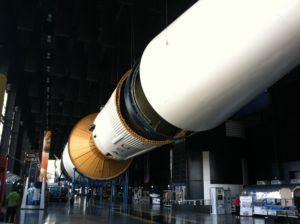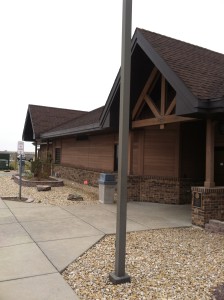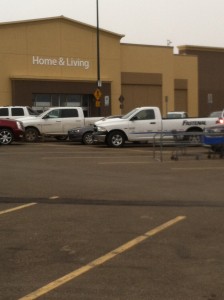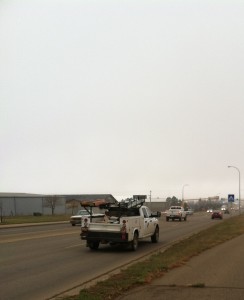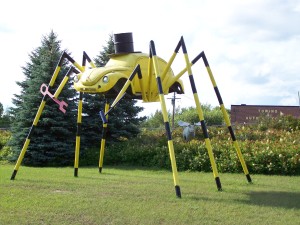I’m eating breakfast at a hotel in suburban St. Louis. It’s a pretty good breakfast with a lot of choices and possibly some real eggs (as opposed to the synthetic polymer common to such venues.) People of every different age, shape, and shade make up the morning clientele. At my one o’clock position is a young mother and her baby. The mother is wearing a St. Louis Cardinals jersey and is patiently handing the little pink-clad girl pieces of banana which the little girl carefully, almost fastidiously, places in her mouth and chews (or gums) until the next bite is ready. She is so quiet and absorbed in the work at hand that it startles me a little when her mother runs out of banana and the little girl looks up quizzically and says, “No more?”
At three o’clock is a girl’s soccer team all eating breakfast together. Kids’ teams are a hazard of the frequent hotel guest and I reflect that this team didn’t wake me up in the middle of the night running up and down the halls. I must say girl’s teams are not nearly the problem in this regard that boys teams are. The team of let’s say 14 year olds are so identical, with one exception, that you could almost believe they were sisters. All but one are thin and blond with long, carefully braided pony tails. Their heights don’t vary more than an inch among the six girls. They all sit the same way on their chairs, seem to have the same food on their plates (yogurt cups and a banana), and, of course, wear matching uniforms. The exception is a young girl in the team uniform who is several inches shorter than the average at the table, black-haired, and, I’m guessing, a Pacific islander. She, too, has the requisite yogurt cup and banana but doesn’t seem to converse with her teammates as the others are doing.
At ten o’clock there is a young bearded man (20ish) in a faded green T-shirt that reads “Roanoke Island Running Club.” He sits by himself but in a way that seems to indicate he is waiting for someone. On his right arm, partially covered by his short sleeve is a tattoo. It is some kind of odd looking bipedal creature whose head is obscured. My first guess is the Michelin Man. That would be odd, of course, unless the guy really has a tire fetish or something. The Stay-Puft Marshmallow man would also fit the bill, or perhaps the Pillsbury Dough Boy, but the tattoo is really not rounded enough for either of these. Finally, as he leans over to pick up a napkin he has dropped on the floor I see that it represents a person from a bomb squad in protective attire. I assess him to see if he looks like a soldier. He is certainly physically fit enough although the scraggly-looking beard suggests he has been out for some time if so.
To my left and facing the same way is a woman of about 60 with dyed black hair who is wearing a loose cotton pastel blouse and a short white skirt that would be eye-opening on a woman half her age. She is unselfconscious about her revealing attire and so I think this is a sort of uniform for her. She flirts briefly with the front desk clerk when he comes out from behind the desk to check something on the breakfast buffet. He blushes at some suggestion she makes that I cannot hear. I admire her a little for not acting her age but also feel a little embarrassed for her. Even at 46, I understand that I can only get away with so much in the “young at heart” department. I set off fireworks and “fell in” the creek on our farm over the 4th of July holiday, which is okay when I am playing with the kids but might be questioned if I was by myself. I don’t want to be old. I guess this lady feels the same way. One of the teenage soccer players gives her a withering look and waggles her pony-tail. “To hell with you, pony tail! Time will get you, too.”
My interest is drawn, necessarily, to a couple sitting directly in front of me on the other side of a small railing/ barrier which bisects the dining room. Their table is at right angles to mine but so close that it is almost as if I am sharing a table with them. Only the top of the barrier separates us. The man is older, maybe 65, and thin. He is lean in a way that suggests not only life-long wiriness but perhaps a recent struggle with, what, cancer maybe, or a heart valve problem. He doesn’t look ill now, but it is apparent that it wouldn’t require much to put him in the category “frail”. His hair, once black, is now shot through with grey and he wears a small, neatly trimmed grey mustache. He has a proud bearing and sits, with excellent posture, chewing his eggs. He is as white as white can be. His skin is thin and almost translucent in spots where it has been drawn tight, such as the bridge of his nose. He has the kind of prominent Adam’s apple that some thin men seem to have and it bobs up and down aggressively as he drinks his orange juice. Everything is dignified about this gentleman with the glaring exception of an impressively flamboyant Hawaiian print shirt. It becomes clear to me over the course of our time together that he did not choose the shirt but is wearing it for the benefit of his wife, who sits opposite him.
The wife is as different physically, almost, as can be. She is a short woman and heavy set. I guess that she is about 5’ 4’’ to his 6’ 2”. The term pear-shaped was invented for her it seems and the term stubby would easily apply to her arms, legs, fingers, and probably toes. She is, I’m pretty sure, Vietnamese, or perhaps Laotian. She has a dark complexion. Whatever other physical characteristics she might have, or shortcomings for that matter, are overcome by an omnipresent and beautiful smile. The smile, and the lack of wrinkles on her face make her seem younger than she probably is. It seems to me that she must have been very pretty as a girl.
As they eat, they chat politely and I might say lovingly with each other about their trip. I do not catch all the details due to a group of noisy new arrivals to the breakfast buffet. I think they have been to a family gathering, maybe even a family reunion. She is solicitous of his every need, looking up from her breakfast at his least cough or clearing of the throat. She butters his English Muffin for him and, at length, produces one of those large pill cases which is divided into days of the week. She removes Thursday’s compliment of medicine, five large colorful capsules, and arranges them neatly beside his plate in what I understand to be an “order of consumption.” She solicits his advice and help with the toaster, even though it is clear to me that she knows how to do it just fine. All this she does for him, not dutifully, but lovingly. She wants him to be okay and she wants him to still feel relevant and valued.
It is clear that they have been married for many years as each of their respective moves is obviously anticipated by the other gratefully. He peels her slightly green banana for her, breaking the tough stem loose and pulling back a couple of the peels before handing it gently to her. At the same time, she hands him a cup of coffee into which she has poured one packet of sugar and a half a container (only half, mind you) of creamer. It is clear that this ritual is of long standing and represents one of those dollops of mortar which bind together a long and happy marriage.
The husband and wife consume their breakfast at half volume (compared to the other guests, anyway) and I find that I am struggling to eavesdrop on their murmured conversation. There is much I want to know. And since I can’t know my mind wanders into a game of “What is their story” much like I did in Philadelphia with the office window and with my son on the streets of Chicago. As they finish their breakfast my imagination intrudes itself into their quiet lives. Here is what I thought:
How did this odd couple meet and why are they so clearly devoted to each other? Time and familiarity can build a bond like this in some relationships just as it can lead to contempt and disgust in others. I think there is something deeper here though than just becoming acquainted with each other’s habits through long observation. There is a gratefulness to her devotion that seems to transcend the daily squabbles and work of marriage. And, though subtler than hers, his actions and clear adoration of her reveals that he still desires to be her “knight in shining armor” and would gladly hurl his pitiful frail body against a dragon if one showed up here in the St. Louis hotel. This couple’s relationship has, I think, been welded in the fire of adversity and they have clearly been through something difficult and traumatic together which is belied by their serene and mundane breakfast together.
Their Story
He was a young boy, living on a farm in southeast Minnesota in 1968, the year I was born. He was a strong boy, and handsome. Perhaps a bit on the tall and “gangly” side, he nevertheless possessed a bright and cheerful face and a quick and friendly smile. He liked hot rod cars and his Dad, who farmed about three hundred acres of corn and soybeans near Spring Valley, had given his “boy” a truckload of soybeans from the bin and told him to deliver it to the elevator, receive the check in his own name, cash it, and buy a 1964 Mustang he had been salivating for. This generosity was typical of his father but also the boy had been a good boy all his life. He did his homework, got good grades, was devoted to his mother and father, and worked hard on the farm. Driving the Mustang home he couldn’t help taking a circuitous route which looped past the homes of each of his high school buddies. When he got home, near the apex of joy which is possible for a young man, there was an envelope laying on the kitchen table with his name on it.
It’s not that he hadn’t thought about Viet Nam. Every boy in America his age had thought about Viet Nam. Actually, when he reflected on it later, there were very few thoughts about the future, at that point, or even the present which were not tangled up by the thorny vine of Viet Nam. It was ever present in his thoughts but somehow in the background, too. It was so abstract. Here was this place which he probably could not find on a map, where boys from Minnesota and Iowa and Wisconsin were going, against their will. And these innocent young farm boys and city kids too were killing people. They were killing people they had not given one thought to in their brief lives and also … they were being killed there.
In less than six months, his Mustang sat in a back corner of the barn with a tarp over it and he was in Hawaii, a place he had never been and had never thought much about. The serene and beautiful days there were short in number and he thought back on them many times in contrast to the foreign and sometimes ugly place he would later be.
What he discovered in Viet Nam was heat and humidity and boredom, at least for the first few months. Later he would discover noise – noise on a scale he had never imagined. He had thought nothing could match the discomfort and misery of baling hay in August in Minnesota. But the humidity in Saigon defeated even his vivid imagination. A cold shower gave just the briefest respite because almost as soon as the valve was shut off the heat bulldozed back in to rejoin the humidity of the shower stall. Doing any work at all caused a torrent of sweat to gush from every pore and, to add to the misery, it did not evaporate but simply wicked into his clothing to give him the sensation more of splashing around in a blood warm pool than walking. Riding fast in a jeep was some relief but there were few opportunities to do so in this teeming city and he found it unsatisfying when he did, comparing the experience with driving Minnesota highways in his Mustang. The boredom was palpable for the first few weeks in Saigon. The work was mind-numbing (filling sandbags, digging holes) and was punctuated by long periods of sitting around in the sun waiting for further pointless orders.
Sometimes change, even for the worse, can be a relief and when he got orders to climb aboard a chopper headed for the country’s interior he was almost glad for the opportunity to do “something else – anything else.” This feeling was short-lived, though, as too much of one thing, monotony, was quickly replaced by too much of another, fear.
The noise was a big part of the fear. It was ceaseless and stupefying. And there was an odd sense of disorientation with it since some of the noises were routine, and harmless; generators running full speed, jeeps racing back and forth, choppers, the clang of pots and pans in the mess hall. But intermixed with the drone of the mundane were sounds that would literally kill you, the scream of mortar rounds, the staccato “tat-tat-tat” of machine guns, and the deafening roar of the 155 mm howitzers. The boy spent a lot of time in base trying to morph in his mind the olive green jungle around him into the verdant rows of corn back home. He was not too successful.
Finally the day arrived when he was selected to go out on patrol to a village near the base. There was news that the Viet Cong had infiltrated the village and were using it as a staging point for recent attacks against the forward air base. The boy was scared, naturally. But again it seemed that change, any change, held an dark allure. He had stared at the jungle until his eyes were blurry on watch. He had listened to the noises, the noises, the noises, until he could not stand it anymore. He stepped up into the Huey with a sense of foreboding mixed with a sense of relief. Something might happen but something was better than nothing.
The village was tiny and sat out in the middle of a flat open plain of dried up rice paddies surrounded at a distance by dense jungle forming almost a wall at its edge. Low dikes broke up the landscape into an checkerboard pattern with the village of thatch-roofed huts in the center. This was a resettlement village and was home to about 150 peasants, 50 PF’s (Popular Front soldiers from the South Vietnamese Army), and 5 CAP’s. CAP’s were American soldiers assigned to the Combined Action Program. These soldiers lived in the village with the peasants and protected them and helped them with things like digging wells, repairing structures, and building dikes. They lived in fear and trepidation as the the little village was under constant attack from the communists massed in the jungle just to the north. The PF soldiers, while officially there to defend the village, were not from there and were not crack military troops. The American CAP’s would often hear rumors of communist attacks and in the morning find many of the PF’s had slipped away or hidden their uniforms to blend in with the local villagers in case the Viet Cong overran the village. When the attacks did come they were usually not straight up gun fights. They could take the form of mortar rounds suddenly landing all around them in the village, booby traps laid along paths during the night, or in one horrible case, a twelve year old boy heaving a hand grenade into the middle of the CAP’s as they were eating dinner. There were sometimes firefights and if the CAP’s were lucky enough to hear rumors of them from the local villagers, they could call in support from the local bases. This time the CAP’s had heard such rumors from credible sources and had noted that about a quarter of their PF’s had disappeared into the night. The boy’s unit was called in for the first time. It would not be the last.
As the choppers circled in a wide arc around the village, there was no sign that there was anything menacing at all here. The boy looked out, with great concentration, as the Huey settled onto a dike a few hundred feet from the outskirts of the village. For a few moments dirt and dust were everywhere in the air, churned up by the rotor downwash. The boy found himself shoved bodily out the door and onto the hot ground.
In a moment the chopper was gone, as he had been told it would be. Lingering would have been suicide for the pilot and the gunner as such a target was a great temptation for the Viet Cong back in the trees. The boy gathered his weapon and backpack and used it to push himself into an upright position. When he did this and rubbed the dirt out of his eyes, the first thing they fell upon was the smiling countenance of a young Vietnamese girl. She was his age and she giggled as he brushed the dust off himself. He had never really believed in love at first sight but he knew then, instinctively and immediately, that the greatest thing he could aspire to for the rest of his life was to elicit this smile and this giggle from this girl. He blushed a vivid crimson which was not lost on his Lieutenant.
The girl took a couple of steps forward and held out her hands in which was a steaming cup of tea. She offered it to him and in very broken English said “Here sir, some tea for you.” He chuckled to think of the term “sir” applied to him who for months had only heard the words “scum, and maggot, and boy” applied liberally by his drill sergeant back in California. He dropped the pack and took the offering, a thin metal cup so hot that it must have been very uncomfortable for her hands to hold as she waited for him to make up his mind. The Lieutenant, another tall farm boy from Tipp City, Ohio, whom the boy had found to be friendly, likable, and approachable nodded at the girl and winked at the boy. “Your watch is 2200, why don’t you let her familiarize you with the village. It’s important that we fully understand what’s going on here and find out who we can trust.” The boy knew that the Lieutenant had already had a thorough debriefing by the CAP’s. The girl smiled even more broadly, if such a thing was possible, and beckoned for him to follow her to the common dining hut which the villagers, the PF’s and the CAP’s shared. She took his hand and the touch of her skin thrilled him as he had only experienced once before. He remembered now that he had been solely in the company of men for 65 days. This new sensation was a thing he could get used to. Through a strange alignment of the stars, he had an opportunity to do just that.
This village remained, for nearly four months, the target of Viet Cong threats. The CAP’s were far outnumbered by the communist strength in the nearby jungle. The PF’s assigned to the village were flighty and undependable. The boy’s platoon was called back time after time to stand guard over the village at night and make forays into the edge of the jungle to root out the Viet Cong. The boy, to the surprise of everyone except his Lieutenant, volunteered for this duty every time. Even the horrors of the jungle and what were increasingly suicidal patrols were insufficient to prevent him from spending time at the village. Four men he knew well were ambushed on such a patrol, their bodies found the next morning just yards from the edge of the tree line, riddled with bullets.
Occasionally he and several members of his platoon would stay in the village for a week at a time when the threats of attack were credible enough. He watched over the villagers paternally as they went about their subsistence farming. He played with the children and watched them play. And he watched over one hut in particular and was loathe to let it or its occupants out of his sight. When he was ordered back to the base at the end of such a deployment, he lingered and resisted, even begging his Lieutenant to let him stay on as a CAP. At length he would board the Huey and watch out the open door as long as he could until the little village merged into the dark green blur of the jungle passing below.
He hated leaving her and he hated the Viet Cong for starting this absurd war and he hated the other soldiers in his platoon who looked at the girl and saw something very different than he did. He almost punched one of the men, a loud-mouthed cocky son-of-a-bitch from Jackson, MS who had made a lewd remark about the girl. The Lieutenant had overheard the exchange and ordered the boy off to some made-up duty on the other side of the village. The next afternoon the son-of-a-bitch from Mississippi stepped on a booby-trap near the latrines and blew one of his legs completely and cleanly off and mangled the other grotesquely. After helping to load him onto the evac chopper, the boy hid behind the mess hall and cried.
Another day a single mortar shell came screaming out of a clear blue sky and exploded almost on top of a water buffalo and an old man trundling behind it through the rice paddy. The boy was only sixty feet away and when he ran to help the old man found that the bomb had done such a thorough job that he was unsure which bloody part belonged to the buffalo and which to the man. The old man, it turned out, was the girl’s uncle and when he told her about it her smile faded for the first time in his memory. Horrified at what he had done, he spent the rest of the day trying to rekindle that precious smile. At length he simply held her in his arms and squeezed her.
She did not smile again for days and he felt he would rather have spray painted graffiti on the Mona Lisa than have defiled that lovely life-giving smile of hers. He was finally able to coax it back with a little card trick he had learned in basic training but he felt, forever after, that this had been an unworthy, desperate, selfish thing for him to do. He had cajoled that smile, her smile, for his own purposes, because he needed to see it. Little did he know that she offered it up to him as a gift to assuage his sadness and guilt even though she had not yet felt ready to smile.
Nearing the end of his tour of duty the boy became distraught at the idea of returning to Minnesota and never seeing the girl again. He could not countenance the thought of her remaining in this village which would surely be overrun and the villagers massacred by the Viet Cong as traitors. She assured him she would be alright but he could tell that, once again, she was offering him up this fantasy as a gift. He conjured up increasingly implausible schemes by which he would spirit her off to Saigon in the back of a jeep under a tarp. He considered going AWOL and simply joining her in the village to await whatever fate dealt them. He could not imagine his world without her in it.
On his last deployment to the village he landed with a heavy heart and went directly to her family’s hut. She offered him tea and set by the fire with him talking for hours, sharing thoughts and dreams and fears.
Near dusk the boy heard a distant popping sound coming from the jungle to the north. He recognized this, immediately, as AK-47 fire and peered up over a low wall to see what he could see. What he saw sent a wave of fear and nausea through him. Advancing slowly across the furthest rice paddies were hundreds of Viet Cong troops fearlessly and brazenly crossing open ground and headed for the village. He then heard the thump of mortars being fired from the trees and the earth twenty yards to their right suddenly exploded into a shower of dirt, rocks, and debris. The CAP’s raced to the machine guns and laid down a withering fire in the direction of the communists but it did not stop them.
The boy grabbed the portable radio set and the girl’s hand and they raced to the mess hall where he knew the Lieutenant to be. The Lieutenant emerged as they approached and with incredible composure took the radio set and began transmitting instructions and numbers to someone listening on the other end. The boy didn’t really understand what the Lieutenant was saying but he knew what the conversation was meant to result in. The lieutenant had called in an airstrike which meant the calm and collected officer thought the situation was dire. The boy grabbed the girl’s shoulders, looked her in the eye, and told her to return to her home and hide in the root cellar below the hut’s floor. She shook her head. He insisted and drug her that direction. She relented finally and ran for the hut. He followed her progress until she disappeared inside and then grabbed his M16 and knelt beside the CAP’s to hold off the attack until the planes could arrive. He wasn’t sure that was possible.
Despite the CAP’s steady fire the Viet Cong advanced, stepping over their dead comrades and coming on. Minutes seemed like hours to the boy as he replaced cartridge after cartridge and the barrel became a branding iron if touched. He was no longer thinking about the people he might be killing or even the possibility of being killed himself but only concerned that he hold off just long enough to protect the girl and her family.
When it seemed impossible to hold off the oncoming enemy any longer, he finally heard, off to the South, the screaming roar of two F-4 Phantom jets just above the trees and coming on fast. He hit the ground as the first unloaded its weapons seemingly just over his head. The bombs continued forward and down as the F-4’s streaked forward and up twisting rapidly to the left and disappearing into the clouds just as the napalm exploded all around him with a deafening roar. The enemy soldiers in front of him simply disappeared into the conflagration and as he rose unsteadily he turned around to find that much of the village had, too. One of the bombers had dropped its load a split second early and at least one or two napalm bombs had burst in the middle of the village, turning the nearby huts into an inferno.
He raced to the girl’s hut finding it fully engulfed in flames. He rushed in through the opening and unmindful of his own burns tore open the hatch leading down into the root cellar. The girl lay curled in the tiny space dazed but unhurt. The boy could see that her father and mother had not made it into the cellar but had been killed by the concussion of the explosion. The girl looked up into the eyes of the boy surrounded by wreckage and flames and smiled. He smiled back. He pulled off his coat and wrapped it around her, taking care to cover her head, not only to protect her from flames but also to protect her from a sight which might have lingered with her for the rest of her life. He picked her up and carried her out through the door of the hut just as it collapsed into a pile.
During the escape, the boy had been burned badly on his exposed arms and scalp. He fell to his knees near the flaming mess hall taking care that the girl not fall on the ground. When he looked at her again, he found her smile gone and replaced with a look of fear and concern focused on his chest. He looked down to find that his shirt was covered in blood apparently the result of shrapnel from one of the napalm bombs or mortar shells. He was suddenly dizzy and he slumped to the ground as the world went dark around him.
When the evac chopper arrived moments later, the rotor wash fanned the flames into a frenzy of searing heat. The Lieutenant, who had seen everything from near the machine gun emplacement, carried the boy like a rag doll to the landing site. He pushed the boy into the open door of the chopper where a medic went immediately to work on his wounds. Then, to her surprise, the Lieutenant whirled and grabbed the girl below her arms and boosted her into the chopper, too. The gunner, surprised and uncomprehending, objected to this Vietnamese girl’s presence and pushed her back toward the open door. The Lieutenant leaned in close and said something in the gunner’s ear which the girl could not hear. The gunner scowled and pulled the door closed with the girl still aboard. The chopper, seeming to struggle and beat at the air frantically, cleared a flaming palm tree and then soared into the fiery orange sky. Neither the girl nor the boy ever returned to the village and neither ever saw the Lieutenant again.
Back in St. Louis
As I finish my cereal and my reverie with the old couple’s lives I notice that the man in the Hawaiian shirt has paused in his chewing. He grimaces a little and I think he has started to choke. His wife, the girl from the chopper, looks worried and pushes back her chair, preparing to rush to his side. He winces again, swallows, and takes a drink of orange juice. Then he gives her a little thumbs-up sign and grins in a goofy sort of way. She smiles her wide smile and lays her little hand in his outstretched palm. No more words are exchanged that I can hear.
The soccer team gets up noisily and leaves. The little girl in pink has finished her breakfast and her mom picks her up. She looks quiet and thoughtful. Then she smiles. I would like to know more about all of them. I see these people every day in hotels and airports and on trains and busses and I get snippets of their conversations. As they pass I catch partial sentences and non-sequiturs. One day I heard a man on a cell phone at O’Hare say clearly and rather sternly to someone on the other end “that is the kind of thing that will get us put in prison!” He passed by and his conversation and his odd story continued and I never saw him again. That happens to me a hundred times a day in my line of work. So, I have to make up stories for them.
I had to leave to go catch my van to the airport. I never saw the old couple again and probably, barring some miracle, never will. Their story now is the one I made up for them. But whatever it was in real life I like to believe that their story continued and had a happy ending.
by: Dustin Joy










